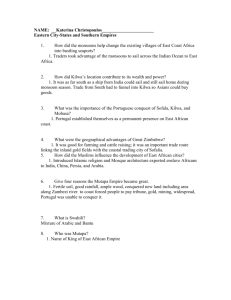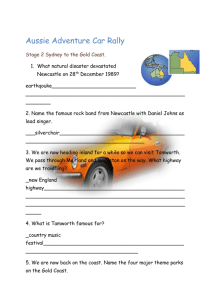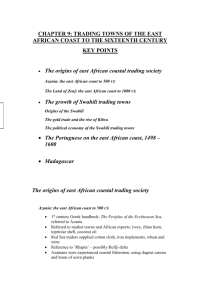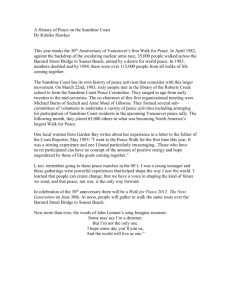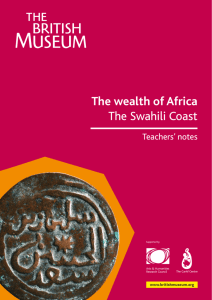THE EAST COAST CULTURES
advertisement
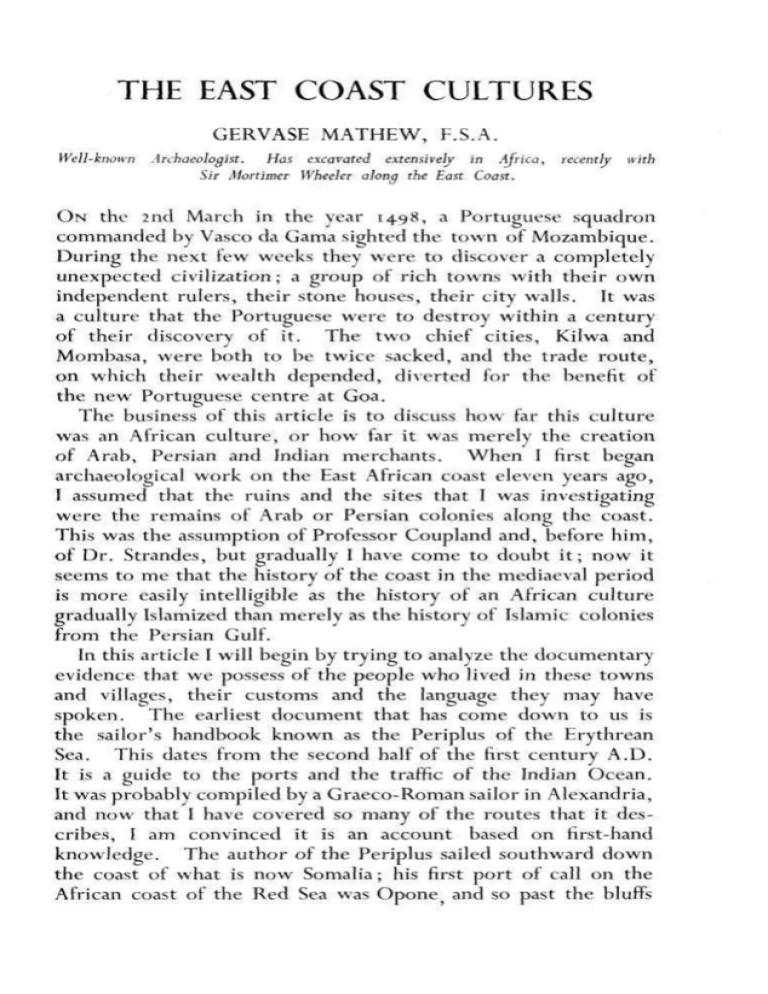
THE EAST COAST CULTURES GERVASE M A T H E W , F.S.A. Well-known Archaeologist. Has excavated extensively in Africa, Sir Mortimer Wheeler along the East Coast. recently with O N the 2nd March in the year 1498, a Portuguese squadron c o m m a n d e d by Vasco da Gama sighted t h e t o w n of Mozambique. During the n e x t few weeks they w e r e to discover a completely u n e x p e c t e d civilization; a group of rich towns with their o w n independent rulers, their stone houses, their city walls. It was a culture that the Portuguese w e r e to destroy within a century of their discovery of it. T h e t w o chief cities, Kilwa and Mombasa, w e r e b o t h to be twice sacked, and the trade r o u t e , o n w h i c h their wealth depended, diverted for the benefit of the n e w Portuguese c e n t r e at Goa. T h e business of this article is to discuss h o w far this culture was an African c u l t u r e , or h o w far it was merely the creation of Arab, Persian and Indian m e r c h a n t s . W h e n I first began archaeological w o r k on the East African coast eleven years ago, I assumed that t h e ruins and the sites that I was investigating w e r e the remains of Arab or Persian colonies along the coast. This was t h e assumption of Professor Coupland and, before h i m , of D r . Strandes, b u t gradually I have c o m e to d o u b t i t ; n o w it seems to m e that the history of the coast in the mediaeval period is m o r e easily intelligible as the history of an African c u l t u r e gradually Islamized than merely as the history of Islamic colonies from the Persian Gulf. In this article I will begin by trying to analyze the documentary evidence that w e possess of the people w h o lived in these towns and villages, t h e i r customs and the language they may have spoken. T h e earliest d o c u m e n t that has c o m e d o w n to us is t h e sailor's handbook k n o w n as the Periplus of the Erythrean Sea. This dates from the second half of the first century A . D . It is a guide to the ports and the traffic of the Indian Ocean. It was probably compiled by a Graeco-Roman sailor in Alexandria, and n o w that I have covered so many of the routes that it describes, I am convinced it is an account based on first-hand knowledge. T h e author of the Periplus sailed southward d o w n t h e coast of w h a t is n o w Somalia; his first p o r t of call on the African coast of the Red Sea was O p o n e and so past the bluffs 60 AFRICA SOUTH of Azania to the Pyralean Islands, to Menouthias, and at last to the Metropolis of Rhapta. In each case he states the sailing distance, and I believe that most of the little ports that h e refers to can b e identified—Ras Hafun, Au Garuin, P o r t Durnford, the Lamu Islands, and then I b e c o m e m o r e doubtful; possibly Mombasa, then possibly Pangani or the Ruviyi on the coast of Tanganyika. For o u r purpose, the i m p o r t a n c e of the Periplus is the proof it gives of the existence of small ports and centres of population w h i c h w e r e visited by traders w i t h iron to b a r t e r and w i n e for gifts. They have links w i t h the Arab cities. T h e natives are tall m e n , in some sense perhaps still savages, and yet clearly w i t h a rudimentary organization. W h o w e r e they? H e r e an historian or an archaeologist can only guess, b u t it is at least possible that they w e r e Negroid and even perhaps speaking some early form of Bantu, for o u r n e x t group of documents show the coast as being inhabited by Negroes w h o apparently speak an early form of Bantu, and the trade still centres a r o u n d the same areas. T h e greatest of Arab geographers, Al Masudi, finished his w o r k entitled " T h e Meadows of Gold and the Mines of G e m s ' ' in 9 4 7 . H e describes the East African coast as the land of Zanj. Its people are Negroes, j e t black w i t h hanging lips. They are idolators, b u t they have a capital city. They have a king w h o is entitled the Son of the Supreme Lord. They h u n t the elephant for ivory, b u t ivory is only an e x p o r t . They themselves use ornaments of iron. They fear the spirits of the dead. They worship trees. H e quotes t w o of their w o r d s , and both of these suggest a Bantu derivation. In the 12th century another Arab geographer, Al Idrisi, gives a m o r e detailed description of the land of Zanj. It is still described as a land of blacks and of idolators, b u t t h e r e is m o r e emphasis o n the existence of t o w n s . H e mentions Malindi by the m o u t h of a great river, and the t o w n that he calls Elbanes w h e r e the people worship the great d r u m called Errahim, and T o h n e t which is close to a high mountain. Merchants c o m e to the towns n o t only for ivory, b u t for iron and for gold. At the end of the 13th century the geographer, Dimashqui, still describes the East African coast as infidel c o u n t r y inhabited by Negroes w h o practised rites that had b e e n handed d o w n to t h e m and w h o w e r e famous for their eloquence at feasts. Sometime in the 13th and early 14th centuries, the culture of the coast becomes integrally Islamic. W e still hear of pagan THE EAST COAST CULTURES 61 "zanjis," but now they are in the interior. Yet even if the culture has become Islamic, still it would seem to be Negro. In the autumn of the year 1330, the greatest of all mediaeval travellers, Ibn Battuta, left Aden for East Africa. He landed first at Zeila. He writes that the people there are black-skinned and that many of them are heretics. The fact that he describes them as heretics at least shows that they had accepted Islam. From Zeila he sailed for 1 c nights to Mogadishu. It is a large and wealthy city. It is ruled by a sheikh who keeps great state. He and his people are devout Mohammedans. But they speak a first language that is not Arabic, and his detailed descriptions suggest a Negro state like those that were coming into existence along the southern borders of the Sahara. He sailed south before the monsoon and spent a night at Mombasa, where he found the people pious and devout and worshipping in wooden mosques. From Mombasa he passed south to Kilwa, which he describes as a very fine and substantially-built town. The actual phrase that Ibn Battuta uses has been translated by Dr. Freeman Grenville as "one of the most beautiful and best constructed towns. It is all elegantly built.'' But the inhabitants of Kilwa are jst black and their faces have been incised, apparently for ornament. There is nothing in the archaeology of the coast which contradicts the account of mediaeval geographers. In some details it corroborates it. Thus the hoard of Roman coins reported from Port Durnford corroborates the trade contacts with the Mediterranean world in the time of the Empire. Only 18 months ago, Mr. Stevenson found skeletons in South Masailand wearing iron as ornaments. Most important of all, the evidence from sites in Somalia, Kenya and Tanganyika suggest an acute cultural transition in the 1 3th and 14th centuries. Mr. Kirkman's work at Gedi, like my own at Songo Mnara, suggest some period round the 13th century as the earliest probable date for the foundation of both towns. With the single exception of a 1 2th century inscription at Kisim Kazi on Zanzibar, we have nothing in stone on the East African coast which can be dated earlier with certainty; perhaps probability is the better word, for it is too early to speak of certainty in African archaeology. The earliest known coin struck in East Africa is that from the Kilwa mint of about 1300. Such a cultural and religious change in the late 13th and early 14th centuries fits in admirably with much else that we know about the history of the Indian Ocean. 62 AFRICA SOUTH For on this hypothesis there had been a gradual development of a town life among the Negro population of the coast stretching over centuries, before the towns became really Islamized and their rulers began to build in stone. The 13th century is precisely the time when one might expect such a change to have taken place. The coming of the Mongols and the fall of Baghdad had caused directly and indirectly a transformation in the balance of Islamic powers, not only in the Gulf area, but far down through India. An increasing demand for slaves and ivory, an increasing need for gold, coming perhaps ultimately from Rhodesia, would stimulate the life and widen the contacts in all the entrepots of the East African coast. On such an hypothesis, the cities discovered by the Portuguese were not Arab or Persian colonies which were becoming slowly Africanized. They were African kingships which had become Mohammedan and which progressively through the 1 cth century had acquired the techniques and the organization of Islamic states. This might explain the fact of which I am becoming increasingly aware—that the often elaborate architecture at Songo Mnara, at Kilwa, at Kua, or Gedi is so curiously different from that of Islamic India, which at first I thought it resembled. Of course there are similarities. These are inevitable since trade contacts were becoming increasingly close towards the end of the middle ages throughout the Indian Ocean. There is no reason to doubt the constant presence of Indian, Persian and Arab traders in all these African centres. They are the white Moors of whom the Portuguese Duarte Barboso wrote. There is nothing in any Portuguese account to suggest that these white Moors were more than a small minority among the black. It is unquestioned that by the 16th century there were already highly prized genealogies that linked the African rulers and traders with ancestors who had been reputed to have come from the Persian Gulf many centuries before. This can be illustrated from the early portion of the 16th century chronicle of Kilwa which bears all the mark of an official myth. It could be illustrated to-day from the use of the term "wa shirazi'* as what is in effect a tribal name on the coast. But all this can be paralleled among the Somalis. For wherever a more primitive society accepts Islam, genealogies have been fabricated and believed in as links with the higher world of Arab culture and ultimately with the times of the Quran.
